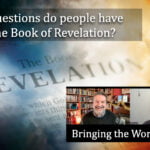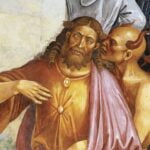The ‘mark of the beast’ in Rev 13.18 is the most notorious and talked-about aspect of the book.
[The beast from the land] also forced all people, great and small, rich and poor, free and slave, to receive a mark on their right hands or on their foreheads, so that they could not buy or sell unless they had the mark, which is the name of the beast or the number of its name. This calls for wisdom. Let those who have insight calculate the number of the beast, for it is the number of a man. That number is 666. (Rev 13.16-18)
The ‘mark’ is clearly an important term in the book, occurring seven times (Rev 13.16, 13.18, 14.9, 14.11, 16.2, 19.20 and 20.4).
There are a few things worth noting here immediately. The first is that John is not here offering an esoteric and mysterious code which requires secret knowledge to unlock. The phrase ‘this calls for wisdom’ is echoed later in Rev 17.9, when we are told about the identity of the Great Whore of Babylon: ‘The seven heads are seven hills on which the woman sits.’ This is a clear reference to the seven hills of Rome; it is not a secret! In the same way, it is reasonable to assume that John expected his readers to understand clearly what he was referring to.
This leads to the second observation. Quite a few commentators argue that we should not try and work out what the number stands for; it is symbolic, and its threefold ‘6’ suggests a falling short and imperfection, in contrast with the number 7 which is associated with God. In fact, 7 is a number of completeness rather than holiness, and the problem with this argument is that it contradicts the plain sense of the text, which in fact tells us to ‘calculate’, to work it out (the verb is psephizo, so you might imagine I have an interest in it!).
Thirdly, another thing which is often missed by commentators is that this mark cannot be interpreted separately from making sense of the ‘seal’ which is put on the foreheads of the 144,000 servants of God in Rev 7.3 (though the act of this sealing is never in fact recounted). Chapter 14 offers two juxtaposed scenes—of the 144,000 who have been sealed enjoying the presence of God, and the rest of humanity who have the mark of the beast facing the judgement of God. In other words, the two marks or seals divide humanity completely into two distinct groups, the saved and the judged. You either have the seal of God, or the mark of the beast; you cannot have both or neither. This is part of the text’s general strategy to raised the stakes in terms of the readers’ relationship with their culture; it is often less about comforting the oppressed, as much as challenging the comfortable to realise that they cannot compromise in their discipleship.
 To read either of these responsibly, we need to consider what John and his readers might have understood by them, rather than randomly associate them with something in our contemporary world. For some time, there has been a strong scholarly consensus that 666 refers to Nero by means of a numerology known as gematria or isopsephism—adding the value of the letters in a word so that every word has a value, and equating two words with equal value. We know that Nero’s name was sometimes spelled with a final -n; ‘Neron Caesar’ when written in Greek, but transliterated into Hebrew letters adds up to 666 (see the image to the right for the sums).
To read either of these responsibly, we need to consider what John and his readers might have understood by them, rather than randomly associate them with something in our contemporary world. For some time, there has been a strong scholarly consensus that 666 refers to Nero by means of a numerology known as gematria or isopsephism—adding the value of the letters in a word so that every word has a value, and equating two words with equal value. We know that Nero’s name was sometimes spelled with a final -n; ‘Neron Caesar’ when written in Greek, but transliterated into Hebrew letters adds up to 666 (see the image to the right for the sums).
There are several significant pieces of supporting evidence for this. First, when you write the Greek for ‘beast’, therion, in Hebrew letters, you also arrive at 666, making it clear that 666 is the number of ‘the beast’. Secondly, when you do the same with ‘angel’ in Rev 21, you get the number 144. Third, an early manuscript from Oxyrhynchus in Egypt corrects 666 to 616, which you would do if you understood the gematria, but thought that ‘Nero’ should be spelled without the final n. (There isn’t really any other plausible explanation for why this variant should arise.)
There has also been discussion about what the mark or seal might look like in Rev 7.3. The passage reuses imagery from Ezekiel 9, where a remnant of the citizens will be seal to protect them from coming judgement:
“Go throughout the city of Jerusalem and put a mark on the foreheads of those who grieve and lament over all the detestable things that are done in it.” (Ezek 9.3)
The word for ‘mark’ here is the same as the Hebrew letter tav, and the equivalent in Greek is the letter tau, which looks like a truncated cross in the same was as our letter T. So some have speculated that this is to do with the sign of the cross; it is the habit of Egyptian Coptic Christians to have a cross tattooed on their wrists as a sign of their faith. However, Rev 7 does not carry this term over, but instead uses the normal word for ‘sealing’. There is some connection, perhaps, with Paul’s language of the ‘seal of the Spirit’ in 2 Cor 1.22 and Eph 1.13.
These discussions might help us with thinking about the reference of the two terms, but they don’t actually address the question of their significance. Whilst writing on Rev 14, I was struck by the fact that the ‘seal’ of the 144,000 has now become the name of the lamb and ‘his Father’s’ name. This is the only time in the body of the vision that the term ‘Father’ occurs; the names appear to have become indistinguishable, just as the worship of the lamb has merged with the worship of the One on the throne; and the merging of names has echoes of Paul’s hymn in Phil 2, where Jesus is give the name above every name, which is the name of God.
But of course the significance of ‘name’ is that is reflects someone’s character and reputation. So the two groups of people, the saved and the judged, are in fact ‘marked’ by the character and reputation of the one that they worship. This links these ideas back to an important them in the OT: we become like what we worship.
But their idols are silver and gold, made by human hands.
They have mouths, but cannot speak, eyes, but cannot see.
They have ears, but cannot hear, noses, but cannot smell.
They have hands, but cannot feel, feet, but cannot walk,
nor can they utter a sound with their throats.
Those who make them will be like them, and so will all who trust in them. (Ps 115.4–8)
In other words, whichever system of worship we ‘buy into’ will shape who we are. This will be visible to those around us, and will demonstrate our allegiances. The choice of whether to receive the mark of the beast, or the seal of God, is then less about being given a secret sign as about choosing how we live our lives. The choice is the same one that Paul describes in Romans 12:
With eyes wide open to the mercies of God, I beg you, my brothers, as an act of intelligent worship, to give him your bodies, as a living sacrifice, consecrated to him and acceptable by him. Don’t let the world around you squeeze you into its own mould, but let God re-mould your minds from within, so that you may prove in practice that the plan of God for you is good, meets all his demands and moves towards the goal of true maturity. (Romans 12.1–2, Phillips)
This might then take us back to the ‘seal’ as cross-shaped and related to the seal of the Spirit. The Spirit of God works in us in order to create the cruciform life in imitation of Jesus himself.
It looks like Revelation, rightly interpreted, is preaching the same gospel as the rest of the NT after all.
(For your amusement, I offer this image which ‘proves’ that Walt Disney is the beast:)
I work freelance. If you have valued this post, would you consider donating £1.20 a month to support the production of this blog?





























Numerology, Paul, is no substitute for true spirituality. Why waster your valuable time?
Ian,
Thanks for this series on Revelation. Ignore Ron’s false dichotomy.
Numerology figures in Christ’s selection of 12 apostles as a signifier of the new Israel formed through the New Testament.
There are also many of the OT prophecies, such as Daniel’s 70 weeks, that are shrouded in similar numerical terms. Ignore Ron’s abrupt and mean-spirited verbal missiles..
It’s ironic that, while your theology might be view as conservative, your blog policy is liberal enough to permit terse corrections from Ron Smith and Simon Sarmiento.
It’s a pity that their liberal Anglican blogs lack your fully inclusive approach towards theological diversity. They appear incapable of disagreeing well.
‘They appear incapable of disagreeing well’…which is not a little ironic!
Dear Father Ron, I don’t think I understand your comment. John is clearly using numerology here. So if I want to understand his spirituality, I need to understand his use of numerology.
Or have I missed something?
I wonder, are those verses in Psalm 115 speaking about us being shaped by our systems of worship, or are they saying something more along the lines that those who worship idols will end up becoming as deaf, blind, mute, and lame as the idols themselves have been described? Or is that just the same thing?
Although you have examined the numerological possibilities of these passages at length and very clearly it seems to me that Fr Ron Smith may have mistaken your intent. The outcome of this study is about our need to choose between rival allegiances which is often an issue for us human beings. And you are surely right that the interpretation cannot be hopelessly esoteric. Revelation announces itself as a book whose meaning is unsealed, in deliberate contrast with the earlier book of Daniel.
Thanks Bob. Yes, I explore this in an earlier post here http://www.psephizo.com/biblical-studies/was-revelation-written-about-the-distant-future/
I have been more and more struck by the way in which Revelation is veiled to us because of our cultural distance rather than anything in the text itself—unless being embedded in a specific cultural context counts as a feature of the text.
Ian Paul, there are a number of insurmountable problems with a preterist view point which discounts any futurist view of Revelation.
1. Both Irenaeus and Hippolytus claim to have known and met people who had conversed with John. Yet neither of them mention ‘neron caesar’. Indeed, to my knowledge no early church father mentions pthe number as being a reference to neron caesar, although undoubtedly he was a type, and an antichrist, and as John said, ‘now many antichrists have come.’
2. Both Irenaeus and Hippolytus spoke of a future time period.
3. In a preterist viewpoint, who were the two withesses? When did the plagues occur, when did they die and when were they resurrected?
4. When did the end of the world, the new Jerusalem and the Great Judgement occur, if it is all historical?
Now it could be that the church fathers and John considered the number as a reference to Nero as a type and an antichrist, but it is clear that if they were, they and John were also speaking of a future time and beast which would manifest itself as a renewed Roman kingdom, being the final kingdom mentioned in Daniel. With hindsight we can see that he spoke of the papacy and RCC. Irenaeus, it seems to me, was more concerned that the number itself should be recorded accurately, because he thought the number would be the actual mark.
Thanks Jacob–but you need to be aware that many of us read Revelation to some extent in a ‘preterits’ way, i.e. that it was written by someone in the first century, to others in the first century, and spoke to them about their lives in the first century (why on earth wouldn’t it, like any other letter?) without its significance being exhausted or its eschatological vision being lost (why would it, like any other NT document?)
It is clear that the meaning of 666 was lost early on–but equally clear from the manuscript variation of 616 that the meaning had not been lost in the first stage of copying. If you are going to disagree with my reading, you need to do so on the basis of the data of the text, and not on patristic reading–which began to get many things wrong, quite quickly.
The two witnesses are a symbol of the whole people of God, the ‘inner temple that is not trampled’, suffering, witnessing and being raised to life as they (we) exercise our ministry of testimony after the pattern of Moses and Elijah (why wouldn’t these be corporate images just as the woman in the next chapter, especially when the two are connected explicitly by the phrase 3.5 years = 1260 days = 42 months?).
As I demonstrate in my commentary, the plagues are a description of life in the first century–and life as it has ever been. John’s readers would have recognised the world of chapter 6 as their world–troubled by warfare, conquest, disease, famine and death. Just look at life expectancy in the first century, especially in the crowded cities (see Rodney Stark).
And it is odd that you connect the term antichrist with Revelation–since the term never occurs there.
Hi Ian, sorry for the delay in response I have only just seen your reply.
I do not find your analysis of the two witnesses to be a natural reading of the text- after all, Moses and Elijah/Elisha/Enoch were real people and performed real miracles. The fact that the two witnesses are described as being possessed with the same abilities implies that they will be real people. You have no scriptural evidence for this, it is merely conjecture.
I am surprised when you say that John does not mention the antichrist in Revelation- he writes about the antichrist elsewhere and that the spirit of antichrist is satanic- in Revelation, the beast system, satan and the false prophet are who the people of God are victorious over. ‘Antichrist’ means ‘in place of’ or ‘substitute for’ Christ, which is exactly what Satan is when he takes the place in people’s hearts and minds and is worshipped. In Revelation, the satanic or antichrist spirit is defeated and cast into the fire. Babylon was the code word for ancient Rome, and Revelation describes a renewed Roman Empire through the apostate Roman Church and its daughters. It is a fact that all popes consider themselves to be Christ on Earth and as you know through history some have gone so far as to actually claim this verbally- as well as statements even more blasphemous-they are not just restricted to papal bulae. ‘Holy Father’ is a term which shoukd be supplied to the One true God Almighty, Yahweh only, not to a man.